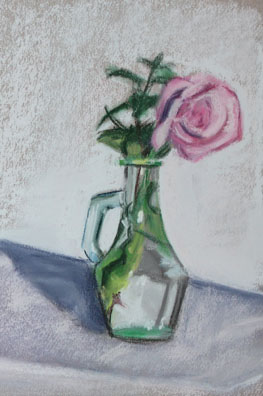Rose in Transparent Vase - Pastel

'Nother rose. This time in a transparent vase. Again the problem - as mentioned in the previous drawing - is this was a real flower which would both open up and orient toward the light. So in the course of the session it tended to move.
Drawing or painting clear and colorless glass is an interesting challenge in that 1) there are many different shapes, 2) there are many different colors, and 3) if you try to draw what you think it looks like it won't look like it.
Instead, you have to draw the shapes and colors as if they are just that - shapes and colors - and not a vase with water and leaves.
Another complicating factor is that colorless glass is not colorless. That's because color refers to the light that comes from the object that strikes the eye. Virtually all objects absorb some light and - quote - "colorless glass" - unquote - does absorb light in the infrared region which is not visible to the human eye. But the absorption of some glasses can slop over into the visible red region. In that case you get less red reaching the eye and so glass tends take on a blue or greenish tinge.
In this case, the actual vase - as opposed to the contents of the vase - is not particularly complicated. The simplicity is best seen in the handle, which is rendered in just a few strokes. Realism is not necessarily complex.